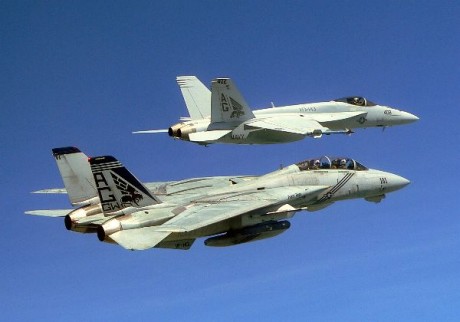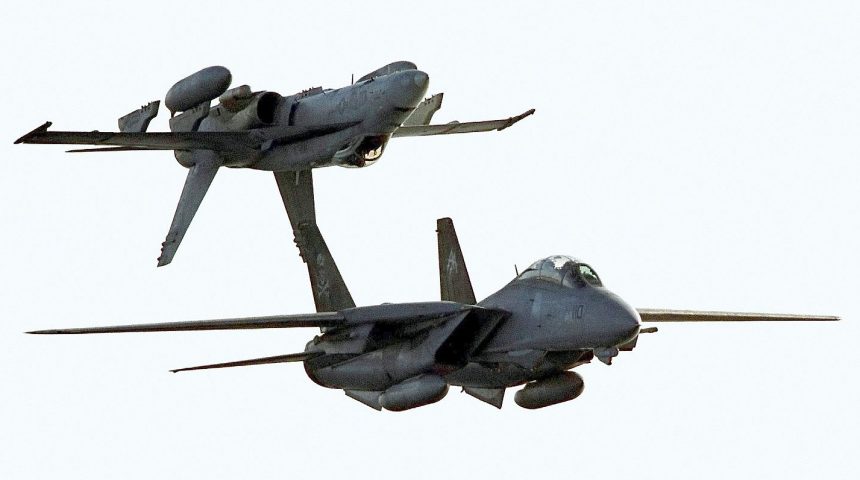Tomcat or Hornet?
Until 2006, the “Wing King” of U.S. Naval Aviation was the F-14 Tomcat. On Sept. 22, 2006, the legendary aircraft made its last flight. Since then, the backbone of every Carrier Air Wing (CVW) is the F/A-18, both Hornet and Super Hornet models.
Although it was retired from the U.S. military service, the F-14 is still in service with the IRIAF (Islamic Republic of Iran Air Force). However, this article does not focus on the outcome of an eventual close encounter between Iranian Tomcats and American Hornets; it is just a comparison between two fantastic flying machines.
So which aircraft would you take to a fight?
The question, of course, it’s very difficult to answer. It depends on the way you see it and may significantly vary from pilot to pilot. However, some assumptions can be made in accordance with the most widely known characteristics of both weapon system, as the author as done in this article with the aim to give readers a comparison between the Hornet and its predecessor.
If the mission is strictly fleet defense, the F-14 was a perfect platform. In fact, the six wing-mounted pylons of the Super Hornet (or the four of the Hornet) impose a higher drag on the F/A-18 that couldn’t match the Tomcat performance as a very high speed interceptor.

Indeed, the Tomcat is known to be a very fast airplane, with great sustained energy performance and, since it carried a great quantity of fuel which gave it a good endurance, the F-14 was also very good for high speed strike missions.
But the Cold War ended a couple of decades ago and “its” Bears bombers are no longer the threat that led to the Tomcat possessing those attributes in first place. Furthermore, while the F-14 was an older aircraft in which some newer technologies were integrated, the F/A-18 Super Hornet is a more modern airplane with newer equipment, easier to maintain: a great advantage in times of budget constraints.
In close air combat, the Super Hornet is much maneuverable (with a good authority at slow speed and high AOA – angle of attack) and, even though it lacks the AIM-54 Phoenix for the long distances in BVR (Beyond Visual Range) engagements, it has got the JHMCS (Joint Helmet Mounted Cueing System) and the AIM-9X Sidewinder for the dogfights, which the F-14 didn’t integrate.
In FAC(A) Forward Air Controller (Airborne) mission both aircrafts have some strengths and weaknesses: while the Tomcat had a greater on-station time than the Super Hornet, the F/A-18 has an integrated cockpit and for air-to ground missions has the capability to carry not only Laser Guided Bombs (LGBs) and Joint Direct Attack Munitions (JDAMs), but also High Anti-Radiation Missile (HARM) and Joint Standoff Weapons (JSOWs) which the F-14 could not carry. Still, the F-14 could carry a reconnaissance pod (although an RF-18 version was produced) while the F-18E fly as a buddy refueler.
Anyway, thanks to its eleven weapon stations, the Super Hornet is more flexible than the Tomcat and it can carry a larger array of air-to-ground ordnance.
So the F/A-18E/F is a great aircraft and a very versatile strike fighter. Still, it’s a Legacy Hornet evolution and it’s not as revolutionary as the F-14 was when it entered the active service in the ’70s, as the most experienced Tomcat driver, Capt. Dale “Snort” Snodgrass, once said.
And, although it was an old plane, according to a female U.S. Navy RIO (Radar Intercept Officer) the F-14 was also a sexy aircraft: “The Super Hornet is a wonderful jet, and it’ s only going to get better. But it will never be cool. The Tomcat was cool. I know sexy when I see it.”








